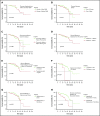Life expectancy and risk factors for early death in patients with severe thalassemia syndromes in South India
- PMID: 32282881
- PMCID: PMC7160270
- DOI: 10.1182/bloodadvances.2019000760
Life expectancy and risk factors for early death in patients with severe thalassemia syndromes in South India
Abstract
In spite of advances in chelation therapy and screening of blood, mortality associated with the most common life-threatening noncommunicable disease of children in India, transfusion-dependent thalassemia (TDT), remains poorly defined. This study aims at estimating death rates and mortality risk factors associated with TDT. The clinical records of 1087 patients from 5 thalassemia centers in India were retrospectively analyzed from 2011 to 2018. Median patient age was 8.5 years, with 107 patients older than 18 years; 656 patients were male and 431 were female. Demographic details and clinical parameters were analyzed at presentation and at last visit. With 41 recorded deaths, actuarial survival at 26.9 years was 50%, and under-5 mortality was 7 times higher than in the general population. Patients with transfusion-transmitted infections (TTIs) had 3.4 times higher risk for death (P = .031). Serum ferritin higher than 4000 ng/dL had 4.6 times higher risk for mortality compared with ferritin lower than 1000 ng/dL (P = .00063). A hemoglobin drop lower than 2 g/dL per week had 7.7 times higher mortality risk compared with a drop of less than 1 g/dL per week (P < .0001). Social determinants (sex, economic status, and distance from center), splenectomy, and even cardiac complications were not associated with higher mortality risk. Main causes of death were infection, iron overload, TTIs, and allo-immunization. Patients who received more than 4 years of adequate care had more than 66% mortality risk reduction (P < .0001). TDT in India continues to result in high mortality. Ineffective transfusion, TTIs, and chelation continue to be the most significant risk factors. Comprehensive care in dedicated day care centers from early age is likely to improve outcomes.
© 2020 by The American Society of Hematology.
Conflict of interest statement
Conflict-of-interest disclosure: The authors declare no competing financial interests.
Figures





References
-
- Company History - Cipla Ltd https://economictimes.indiatimes.com/cipla-ltd/infocompanyhistory/compan.... Accessed 14 December 2018.
-
- Agarwal RK, Sedai A, Ankita K, et al. . Multi-institutional, retrospective review of blood transfusion practices and outcomes in a large cohort of thalassemia patients in South India. Pediatr Hematol Oncol J. 2017;2(4):74-78.
Publication types
MeSH terms
LinkOut - more resources
Full Text Sources
Medical

